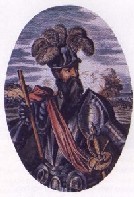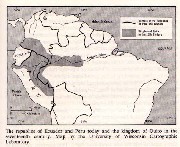
|
When the Spanish arrived in Ecuador, they were searching for a great empire they knew existed in South America. They founded the cities of Quito and Guayaquil to facilitate their expansion throughout the continent. For the indigenous Quichua people, the existence of Spanish colonialism was a blessing and a curse: the Crown government attempted to stem the abuses of conquistadors and encomenderos but also replaced the Inca as rulers and collectors of tribute. |
In
1513, the Spanish conquistador Vasco Núñez de Balboa reached
the Pacific Ocean. Soon, many Spaniards began finding evidence from
coastal Indians that a vastly wealthy empire existed to the south.
In 1532, Francisco Pizarro set out with 200 men to discover and conquer
these people. The Spanish were confident it could be done, had not
Cortez defeated the mighty Aztec Empire with even less? The Inca
Empire was, at this time, recovering from a violent civil war waged between
two claimants for the throne: Huáscar and Atahualpa. By the
time Pizarro reached Incan territory Atahualpa had defeated his brother’s
armies, but the empire was on shaky ground at best.

![]() Atahualpa quickly discovered that a force of foreign invaders had entered
Inca lands. For reasons still not understood, the great Inca decided
to let the strangers pass through the empire without harassment and decided
to meet personally with the Spaniards. There might have been an Incan legend
the predicted the return of white, bearded gods who had sailed away centuries
early, much like the Aztec story of Quetzocoatl.[1] The Inca met
the Spaniards at Cajamarca with an army of 40,000 men. When a priest
showed Atahualpa a bible and told him he must abandon his current gods,
the Inca was insulted and tossed the book down. Using this as a pretext,
the Spanish opened fire on the Indians and captured their emperor-god.
Pizarro ransomed Atahualpa for a gold-filled room, but killed the Inca
rather than return him to his people. By the year 1533 the Spanish
had taken the empire’s capital of Cuzco and the age of Spanish colonialism
had begun.
Atahualpa quickly discovered that a force of foreign invaders had entered
Inca lands. For reasons still not understood, the great Inca decided
to let the strangers pass through the empire without harassment and decided
to meet personally with the Spaniards. There might have been an Incan legend
the predicted the return of white, bearded gods who had sailed away centuries
early, much like the Aztec story of Quetzocoatl.[1] The Inca met
the Spaniards at Cajamarca with an army of 40,000 men. When a priest
showed Atahualpa a bible and told him he must abandon his current gods,
the Inca was insulted and tossed the book down. Using this as a pretext,
the Spanish opened fire on the Indians and captured their emperor-god.
Pizarro ransomed Atahualpa for a gold-filled room, but killed the Inca
rather than return him to his people. By the year 1533 the Spanish
had taken the empire’s capital of Cuzco and the age of Spanish colonialism
had begun.
The
Spanish system of administration in the New World began with a viceroy,
appointed by the Crown, who acted as chief-bureaucrat-governor-general of the anointed viceroyalty sectioned
out by the Spanish government. Viceroys typically opposed the conquistadors
that came before them. They were in America to consolidate royal
power and to protect the indigenous peoples from the machinations of settlers
and local officials.[2] Many were only interested in personal advancement
and cared little for the Indians supposedly under their care. They
were assisted by an audiencia, or council, to rule over the land.
Spain had recently re-conquered most of Iberia from the Muslims and had
yet to fully escape the Middle Ages. As a result, many of the feudal
practices of the kingdom of Spain were transplanted to Ecuador; foremost
among these was the encomienda. The encomienda was a system by which
land, theoretically owned by the Spanish Crown, was given to soldiers and
settlers to farm and/or mine. Any people who lived on that land when
it was transferred were given as slaves to the holders.[3] A landed
elite was created in Ecuador with the labor provided by enslaved Indians.
chief-bureaucrat-governor-general of the anointed viceroyalty sectioned
out by the Spanish government. Viceroys typically opposed the conquistadors
that came before them. They were in America to consolidate royal
power and to protect the indigenous peoples from the machinations of settlers
and local officials.[2] Many were only interested in personal advancement
and cared little for the Indians supposedly under their care. They
were assisted by an audiencia, or council, to rule over the land.
Spain had recently re-conquered most of Iberia from the Muslims and had
yet to fully escape the Middle Ages. As a result, many of the feudal
practices of the kingdom of Spain were transplanted to Ecuador; foremost
among these was the encomienda. The encomienda was a system by which
land, theoretically owned by the Spanish Crown, was given to soldiers and
settlers to farm and/or mine. Any people who lived on that land when
it was transferred were given as slaves to the holders.[3] A landed
elite was created in Ecuador with the labor provided by enslaved Indians.
Ecuador’s indigenous population before the Spanish conquest was between 750,000 and 1 million.[4] Through disease and overwork the people of the coast were practically exterminated within 100 years; the Quichua, the mountain-dwelling peoples were able to survive better by their unfitness to work on hot, lowland encomiendas. Many also escaped into the jungles of the Oriente and Esmereldas. Some assistance came in 1542 when the Spanish government established the “New Laws.” These acts put restrictions on the amount of maltreatment that could be inflicted on Indians and took away many of the titles conquistadors had for Indian workers. As a result many conquistadors revolted against the viceroy. Spanish rule was not restored in Quito and the rest of Ecuador until 1548.
Religiously, the flow of Catholic priests and missionaries into Ecuador was initially spurred by a sense of optimism and impetus to “improve” Indians’ lives through their conversion. With the advent of the Counter Reformation, however, few priests were allowed any room for innovation or experimentation and were soon cooperating with the exploitive encomenderos rather than opposing them.[5] But the encomienda may not have been as oppressive to the Quichua as originally thought. Under the Inca Empire ayllu communities paid tribute, or mita, with a curaca acting as a negotiator; this tribute in goods and labor was largely continued with the Spanish in the place of the Inca.[6]
[1] Marion Morrison, Ecuador, Peru, and Bolivia (Austin, TX: Steck-Vaughn Company, 1992), 28.
[2] C. H. Haring, The Spanish Empire in America (New York: Oxford University Press, 1947), 127.
[3] Roderick Cameron, Viceroyalties of the West: The Spanish Empire in Latin America (Boston: Little, Brown and Company, 1968), 149.
[4] Erin L. Foley, Ecuador (New York: Marshall Cavendish, 1995), 22.
[5] John Leddy Phelan, The Kingdom of Quito in the Seventeenth Century: Bureaucratic Politics in the Spanish Empire (Madison: University of Wisconsin Press, 1967), 52.
[6] David W. Schodt, Ecuador: An Andean Enigma (Boulder, CO: Westview Press, 1987), 21.